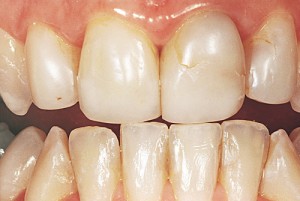This article will tackle basic ideas and concepts that lead to failure of dental restorations, we will simply list them in general points, than in the next few articles will write about them in depth for most dental restorations and the causes.Its always a good start to define what “failure of dental restorations” is.
Failure of Dental Restorations
What Is Failure of Dental Restorations?
A restoration is considered a failure when it fails to perform its functions which it was was inserted for, these functions include:
- Stop Caries and prevents its recurrence.
- Withstand the forces of mastication and remain integral.
- Restore occlusion and function of mastication.
- Restores aesthetics.
- Restores patient comfort and satisfaction.
[space height=”10″]
What is Success ?
The criteria of success of a dental restoration include:
- Restoration remains integral and in place.
- Absence of recurrent Caries.
- Marginal accuracy and adaptation.
- Perfect aesthetics.
- Maintain perfect anatomy and relations with neighboring and opposing teeth and periodontal Structures.
- Patient comfort and satisfaction.
[space height=”10″]
But to reach that success there is criteria one must do to first:
- Dentist: Accurate section of Restoration.
- Dentist: Correct design of cavity.
- Dentist: Perfect material manipulation.
- Patient: Periodic care and maintenance.
[divider scroll_text=””]
[column col=”1/2″]
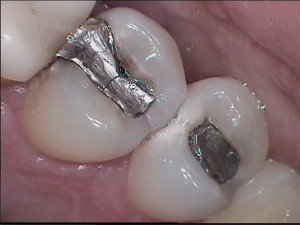
[/column][column col=”1/2″ last=”true”]
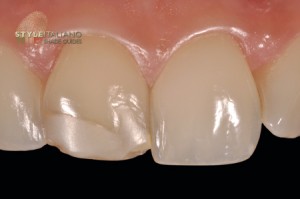
[/column]
[divider scroll_text=””]
General Causes of Failure
Causes of failure can be listed as either inherent factors or induced factors:
Inherent Factors
- Limitations of available restoratives, because basically there is no perfect Ideal restoration that gives perfect mechanical, biological and aesthetic properties, each restoration has its advantages and disadvantages.
- Tough conditions in the oral cavity:
- Different Types of Stress.
- Temperature fluctuations.
- PH Cycling.
- Humidity.
- Micro-organisms.
- Shelters and stagnation areas.
Induced Factors
- Misjudgment in selecting the correct restorative material.
- Incorrect design of cavity preparation.
- Imperfect manipulation of the restoration.
[divider scroll_text=””]
Research
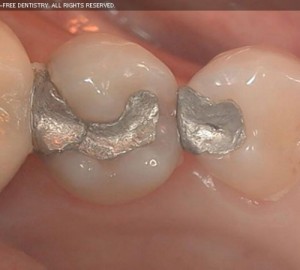
A Research by Bernardo M, Luis H, Martin MD, Leroux BG, Rue T, Leitão J and DeRouen TA, From Portugal Entitled “Survival and reasons for failure of amalgam versus composite posterior restorations placed in a randomized clinical trial” and published in June 2007 stated that:
Backround
Failure of dental restorations is a major concern in dental practice. Replacement of failed restorations constitutes the majority of operative work. Clinicians should be aware of the longevity of, and likely reasons for the failure of, direct posterior restorations. In a long-term, randomized clinical trial, the authors compared the longevity of amalgam and composite. SUBJECTS, METHODS AND MATERIALS: The authors randomly assigned one-half of the 472 subjects, whose age ranged from 8 through 12 years, to receive amalgam restorations in posterior teeth and the other one-half to receive resin-based composite restorations. Study dentists saw subjects annually to conduct follow-up oral examinations and take bitewing radiographs. Restorations needing replacement were failures. The dentists recorded differential reasons for restoration failure.
Results
Subjects received a total of 1,748 restorations at baseline, which the authors followed for up to seven years. Overall, 10.1 percent of the baseline restorations failed. The survival rate of the amalgam restorations was 94.4 percent; that of composite restorations was 85.5 percent. Annual failure rates ranged from 0.16 to 2.83 percent for amalgam restorations and from 0.94 to 9.43 percent for composite restorations. Secondary caries was the main reason for failure in both materials. Risk of secondary caries was 3.5 times greater in the composite group.
Conclusion
Amalgam restorations performed better than did composite restorations. The difference in performance was accentuated in large restorations and in those with more than three surfaces involved.
Clinical Implications
Use of amalgam appears to be preferable to use of composites in multi-surface restorations of large posterior teeth if longevity is the primary criterion in material selection.
Link
http://www.ncbi.nlm.nih.gov/pubmed/17545266
[divider scroll_text=””]
So how is this research related to the article?
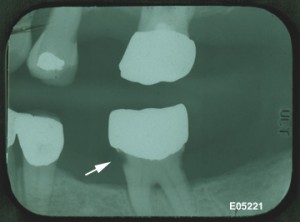
From the research, we can clearly see that each material has its benefits, uses and specific failure, thus its important that we take each material separately and stated the different types of failure and in-depth state the main cause of that failure how prevent it and if it occurred how to treat it.
In the Next Few Articles, we will talk in depth about the different types failure of dental restoration for the following restorations (Amalgam, Cast restorations and Composite Resin)
OziDent Members Only
The rest of article is viewable only to site members,Please Register and/ or Confirm registration via EmailHere.If you are an existing user, please login.
